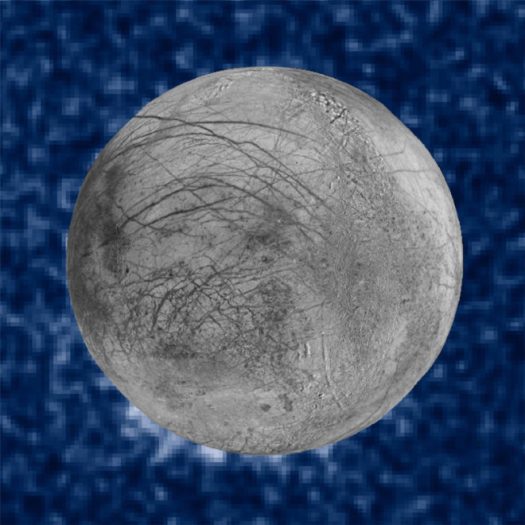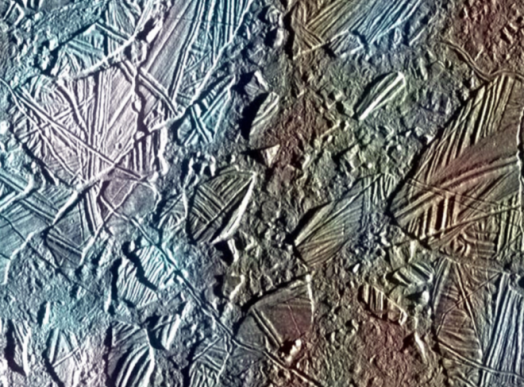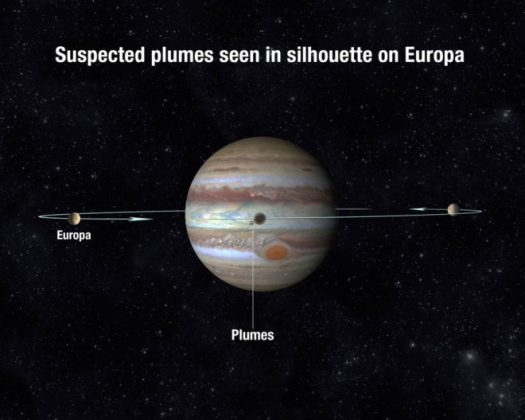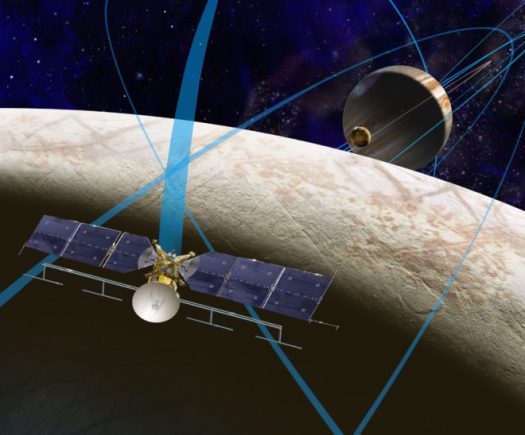
This composite image shows suspected plumes of water vapor erupting at the 7 o’clock position off the limb of Jupiter’s moon Europa. The Hubble data were taken on January 2014, and appear to show plumes that spit out as much as 125 miles. The image of Europa, superimposed on the Hubble data, is assembled from data from the Galileo and Voyager missions. (NASA/ESA/W. Sparks (STScI)/USGS Astrogeology Science Center)
Europa is a moon no bigger than our own and is covered by deep layers of ice, but it brings with it a world of promise. Science fiction master and sometimes space visionary Arthur C. Clarke, after all, named it as the most likely spot in our solar system to harbor life, and wrote a “2001: A Space Odyssey” follow-up based in part on that premise.
Many in the planetary science and astrobiology communities are similarly inclined and have supported a specifically Europa mission geared to learning more about what is generally considered to be a large ocean beneath that ice.
Along the way, Europa became the only object deemed by Congress to be an obligatory NASA destination, and formal plans for such a voyage have been under way — however slowly — for several years. Formal development of the “Europa Clipper” flyby project began last year, after a half decade of conceptual work.
The logic for the flyby got a major boost on Monday when a team using the Hubble Space Telescope reported that they had most likely detected plumes of water erupting out of Europa on three separate occasions.
Because of the difficulty of the observation — and the fact that plumes were found on 3 out of 10 passes — nobody was willing to claim that the finding was definitive. But coupled with an earlier identification of a Europa plume by a different team using a different technique, the probability that the plumes are real is getting pretty high.
And if there really are plumes of water vapor or ice crystals being pushed through Europa’s thick surface of ice, then the implications for the search for signs of habitability and of life on Europa are enormous.
“Europa is surely one of the most compelling astrobiological targets in solar system with its apparent saline oceans,” said William Sparks, an astronomer with Space Telescope Science Institute in Baltimore and lead author of the Europa paper, to be published in The Astrophysical Journal.
“And now there’s the real possibility that we can explore for organics or even signs of life without drilling into the ice.” In other words, the plumes could allow NASA to collect material once in the oceans of Europa via a flyby, rather than requiring a landing and a subsequent piercing through miles of ice.

The findings make it increasingly likely that there are at least two moons in our solar system that have spurting plumes of water vapor. Saturn’s moon Enceladus definitely has plumes — the Cassini spacecraft traveled through one of them, collecting data — and now there’s good reason to conclude Europa does as well. This raises the possibility that icy water worlds around the galaxy are spouting out their insides, and some day they might be measurable as well.
Sparks and other scientists on a NASA teleconference repeatedly emphasized, however, that more needed to be done before the presence of Europa plumes could be deemed conclusive.
“These are challenging observations pushing the limits of Hubble,” he said of their work, which used the Space Telescope Imaging Spectrograph to capture far ultraviolet radiation.
To get their results they used the “transit” method of observing Europa, a technique pioneered by exoplanet astronomers working to understand the compositions of the atmospheres of planets far, far away. That scientists studying possible Europan plumes and methane compositions around distant planets demonstrates just how much cross pollination exists between astronomy, planetary science, astrobiology and exoplanet research have become.
“The atmosphere of an extrasolar planet blocks some of the starlight that is behind it,” Sparks explained. “If there is a thin atmosphere around Europa, it has the potential to block some of the light of Jupiter, and we could see it as a silhouette. And so we were looking for absorption features around the limb of Europa as it transited the smooth face of Jupiter.”
The results were collected over a 15 month period, largely in 2014. It took several years to process the information and check and recheck the instruments and methodologies to limit the possibility of a false positive.
The findings support earlier evidence for water plumes on Europa detected by a team led by Lorenz Roth of Southwest Research Institute in San Antonio. They concluded that water vapor had erupted from south polar region of Europa and reached more than 100 miles into space.
Although both teams used Hubble’s Space Telescope Imaging Spectrograph (STIS) instrument, each used an independent method to arrive at the same conclusion.

Europa is cold — very cold. The surface temperature at the equator never rises above minus 260 degrees Fahrenheit. At the poles of the moon, the temperature never rises above minus 370 F.
So how can there be a large ocean beneath the ice to begin with?
The answer involves heat produced by “flexing” of Europa based on its eccentric orbit and the gravitational pull of Jupiter.
This is how a NASA article described it:
“As Europa’s distance from Jupiter changes over the course of its orbit, Jupiter’s gravitational attraction changes, since gravitational force is dependent on distance. As a result, the tidal bulge raised by Jupiter goes up and down. This flexing causes heating of Europa’s subsurface.”
But Europa, like Earth and every other celestial body, has also been on the receiving end over the eons of material from asteroids, comets, smaller planets and even deep space. In addition to basic elements and compounds, Europa likely had organic material — the building blocks of life — delivered to it as well.
What’s more, the moon no doubt contains long-lived radioactive isotopes brought to it after formation. The decay of these isotopes would produce radiogenic heating, and may play a role in keeping the Europan ocean wet.
Results from prior missions strongly suggest that this water on Europa is salty, adding to the prospects for life. And in 2016, a study suggested that Europa produces 10 times more oxygen than hydrogen, which is similar to the ratio on Earth.

So, that there may well be a habitable ocean between the ice mantle and rocky insides of Europa is well accepted. How might some of that water rise up to the surface and ultimately erupt as a plume?
Britney Schmidt, assistant professor at the School of Earth and Atmospheric Sciences at Georgia Institute of Technology in Atlanta, said it has long been hypothesized that vents open at times between the surface and the water below — if not the oceans, then perhaps some lakes closer to the surface.
This is hypothesized to be most likely in chaos terrain, where features such as ridges, cracks, and plains (be they of ice or rock) appear jumbled and enmeshed with one another. Europa is covered with this kind of geology.
Schmidt, who has studied Europa extensively, described the upwellings as “cryovolcanoes” — small fingers of liquid water pushed up to the surface by the intense pressure of miles of ice above these oceans.
While the presumptive plume activity appears to be most common near the south pole, it is also found elsewhere, including one detection near the equator.

Europa has been on NASA’s radar screen for some time. The National Research Council’s once-a-decade review for planetary science, issued in 2013, made exploration of Europa the agency’s highest-priority mission in that arena. The agency generally follows the NRC recommendations.
As currently conceived, the mission would send a probe and lander to the moon, to be launched in the 2020s. Funding for the estimated $2.3 billion project remains a major issue, but last year NASA asked scientists and engineers to propose designs for instruments. Thirty-three proposals came in and nine were selected.
As it is being developed, the mission would send a solar-powered spacecraft into a long, looping orbit around Jupiter to then perform three-years of repeated close flybys of Europa. In total, the mission would perform 45 flybys at altitudes ranging from 16 miles to 1,700 miles (25 kilometers to 2,700 kilometers).
But later action in Congress — where Rep. John Culberson, a Texas Republican who represents the area including NASA headquarters, has pushed hard for a major Europa mission — added a lander to the project, to be launched two years after the Clipper. Culberson, chair of the House subcommittee that funds NASA, strongly believes that NASA will find the first evidence for life beyond Earth in the ocean beneath the thick surface ice.

The selected science instruments includes cameras and spectrometers to produce high-resolution images of Europa’s surface and determine its composition. An ice penetrating radar will determine the thickness of the moon’s icy shell and search for subsurface lakes similar to those beneath Antarctica. The mission also will carry a magnetometer to measure strength and direction of the moon’s magnetic field, which will allow scientists to determine the depth and salinity of its ocean.
A thermal instrument will scour Europa’s frozen surface in search of recent eruptions of warmer water, while additional instruments will search for evidence of water and tiny particles in the moon’s thin atmosphere.
Curt Niebur, project scientist for the Europa mission, was on the teleconference call as well, and described the increasing possibility that the Clipper will find Europan plumes as enormously exciting and important. He said that the spacecraft will have the ability to change course and head to an area experiencing a plume — should one erupt.
He also said the vehicle could potentially pass through a plume like Cassini did with one of the plumes of Enceladus. Those plumes are larger than anything tentatively detected on Europa and are more predictable in their timing and locations.
But who knows what might be possible?
“We found out a lot about Enceladus by flying through the plume and sampling plume material,” Niebur said. “We would kill to have that kind of information for Europa.”
